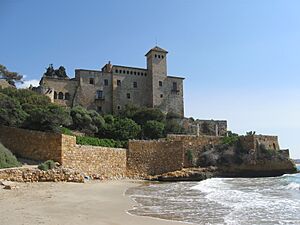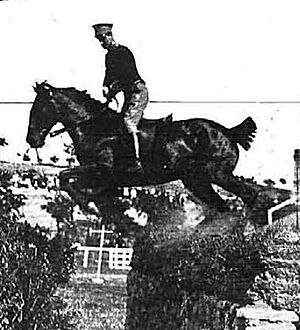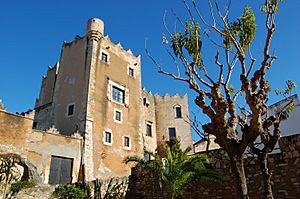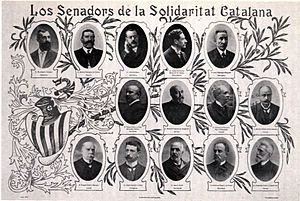Josep de Suelves i de Montagut facts for kids
Quick facts for kids
Josep de Suelves i de Montagut
|
|
|---|---|
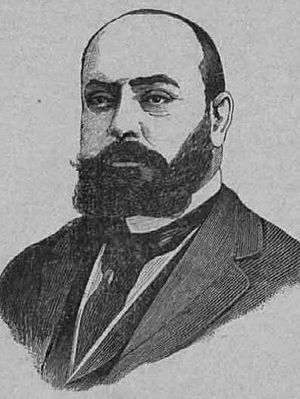 |
|
| Born |
Josep de Suelves i de Montagut
1850 Tortosa, Spain
|
| Died | 1926 Madrid, Spain
|
| Nationality | Spanish |
| Occupation | politician |
| Known for | politician |
| Political party | Carlism |
Josep de Suelves i de Montagut, 9th Marquis of Tamarit (1850–1926) was an important Spanish politician. He was part of the Carlist movement. He served in the Spanish parliament, called the Cortes. He was a member of the lower house for four terms between 1896 and 1910. He also served in the upper house, the Senate, from 1899 to 1900.
Contents
Who was Josep de Suelves i de Montagut?
His Family Background
Josep de Suelves came from two old and respected families in Catalonia, Spain. One of his ancestors, Francesc de Montserrat Vives, was a hero during a war in the 1600s. Because of his bravery, he was given the title of "Marquis of Tamarit" in 1681.
Later, in 1794, the title went to Josep's great-grandfather, Joan Nepomucé de Suelves i Montserrat. This ancestor was a politician who opposed certain ideas in Spain.
Josep's great-uncle, Antoni de Suelves i d’Ustariz, was the 8th Marquis of Tamarit. He was also a Carlist and helped prepare for a new uprising in the late 1860s. Josep's father, Joan de Suelves i d’Ustariz, married Buenaventura Montagut Félez. They had three children, and Josep was the oldest.
His Early Life and Education
Josep grew up on his family's estates in Catalonia. He went to high school in Reus and Tortosa. In the late 1860s, he studied law and philosophy at the Universidad Central in Madrid.
In 1885, he married María Goyeneche Puente. Her father was a diplomat and politician from Peru and Spain. In 1886, Josep inherited the title of Marquis of Tamarit from his great-uncle, who had no children. He also received many family lands around Tarragona.
Josep and María had three children: Juan, José, and Carmen. Their oldest son, Juan, became the 10th Marquis of Tamarit in 1908 when Josep gave up the title. Juan joined the military and became a commander. Sadly, he passed away during a conflict in 1937.
What was the Carlist War?
Josep's Role in the Conflict
When a big change happened in Spain in 1868 and Queen Isabella II was removed from power, the Carlists got ready for a fight. Josep's great-uncle, Antoni, asked Josep to join the Carlist cause. In 1868, Josep left Spain to be with the Carlist leader, Carlos VII. He helped prepare for the uprising.
In 1872, the Third Carlist War began. Josep crossed the border into Spain with Carlos VII. Even though his uncle was in charge of some areas, Josep stayed on the Northern Front. He was with Carlos VII when they set up the Carlist capital in Estella.
Josep's exact role in the war is not fully clear. He was young and didn't have military training. He might have been a helper or a messenger for Carlos VII. He received some military honors and was promoted, but it's not known if he fought in battles.
After the War: Exile and Travel
When the Carlists lost the war in 1876, Josep went with Carlos VII to France. As a reward for his service, Carlos VII gave him the title of "Vizconde de Montserrat." This title was officially recognized in Spain much later, in 1954.
French authorities pressured Carlos VII to leave, so he sailed to Britain. Josep traveled with him. They also went across the Atlantic to the United States and Mexico.
In 1877, they returned to Europe and went to the Balkans. In Romania, they met the Russian Tsar and agreed to join the Russo-Turkish War. Josep and three other Spaniards joined the Russian army. They saw battles and sieges, like the battles of Plevnia. It's not clear if Josep continued to travel with Carlos VII on his later trips around the world.
Josep's Political Career
Becoming a Local Leader
After becoming the Marquis of Tamarit in 1886, Josep started visiting Spain more often. He lived in Paris and his family castle in Altafulla, Catalonia. In the early 1890s, he settled permanently in Altafulla.
In 1891, the Carlists decided to take part in elections again. Josep ran for election in his home district of Roquetes. He lost, blaming political unfairness and a system called "caciquismo." This system meant local powerful people, or caciques, controlled elections.
Running for Parliament
Josep realized it was hard to win in a district with only one winner. So, for the 1896 election, he decided to run in the larger Tarragona district, which had multiple winners. He won and became a member of the Cortes.
For the next 20 years, he ran in almost every election from Tarragona. He won again in 1898, 1901, and 1907. In 1899, the Carlist leader told his followers not to vote, hoping for another uprising. But Tamarit ran as an independent and lost. However, he was elected to the Senate that same year.
He lost elections in 1910, 1914, and 1916. By 1918, he decided it was time to retire from politics.
What was a "Cacique"?
Some historians see Tamarit as a good example of a cacique. These were local party bosses who were very important in the political system of Spain at that time. They often used their influence to control elections and gain support.
Tamarit was very good at making deals behind the scenes with different political groups. He maintained good relationships with the government and other parties. This helped him win elections. He also had genuine support from some rural farmers and very religious voters.
Josep as a Carlist Leader
Organizing the Carlist Movement
When Josep returned to Spain in 1893, he was put in charge of the Carlist movement for the province of Tarragona. He helped turn Carlism into a more organized group. He was known as "l’home fort" (the strong man) and worked hard to set up local Carlist groups. Tarragona province ended up having more Carlist clubs and committees than Navarre, another strong Carlist area.
Josep was against violence during a Carlist crisis called "La Octubrada." However, he might have been part of a secret group in Tarragona that collected money and weapons for a possible uprising. He was not punished by the government afterward.
His Role in National Carlist Politics
In the early 1900s, Tamarit became one of the national Carlist leaders. Even though he officially only led the Tarragona group, he was very influential.
During a political crisis in 1907, Josep supported joining an alliance called Solidaritat Catalana. This alliance included Republicans and Nationalists. He did this because he saw that the Carlist strength in his province was decreasing. He was always keen to protect traditional regional ways but strongly opposed Catalan nationalism.
Josep respected another Carlist leader, Juan Vázquez de Mella, for his ideas and speaking skills. However, he wasn't sure if Mella could be a good leader. When a conflict grew between Mella and the new Carlist leader, Don Jaime, Josep sided with Don Jaime.
In 1917, he was asked to reorganize the Tarragona Carlist branch. In 1919, when many Catalan Carlist leaders left to join Mella's group, Josep remained loyal to Don Jaime. During the time of the Primo de Rivera dictatorship, he did not hold any official positions. He focused on organizing gatherings for the remaining Carlist war veterans.
Images for kids
See also
 In Spanish: José de Suelves y de Montagut para niños
In Spanish: José de Suelves y de Montagut para niños
- Carlism
- Electoral Carlism (Restoration)
- Restoration
- Altafulla castle
- Caciquismo


